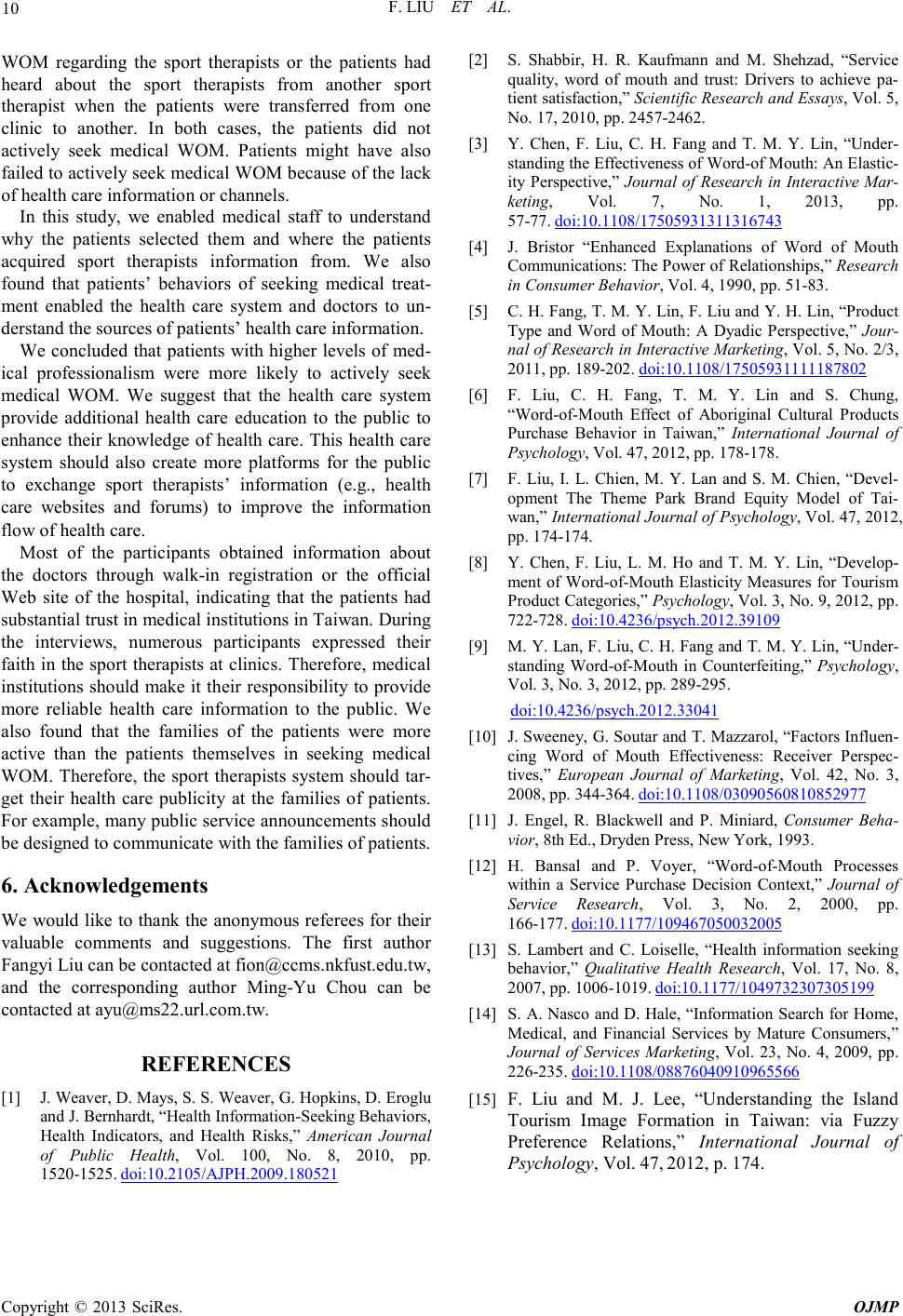
F. LIU ET AL.
Copyright © 2013 SciRes. OJMP
WOM regarding the sport therapists or the patients had
heard about the sport therapists from another sport
therapist when the patients were transferred from one
clinic to another. In both cases, the patients did not
actively seek medical WOM. Patients might have also
failed to actively seek medical WOM because of the lack
of health care information or channels.
In this study, we enabled medical staff to understand
why the patients selected them and where the patients
acquired sport therapists information from. We also
found that patients’ behaviors of seeking medical treat-
ment enabled the health care system and doctors to un-
derstand the sources of patients’ health care information.
We concluded that patients with higher levels of med-
ical professionalism were more likely to actively seek
medical WOM. We suggest that the health care system
provide additional health care education to the public to
enhance their knowledge of health care. This health care
system should also create more platforms for the public
to exchange sport therapists’ information (e.g., health
care websites and forums) to improve the information
flow of health care.
Most of the participants obtained information about
the doctors through walk-in registration or the official
Web site of the hospital, indicating that the patients had
substantial trust in medical institutions in Taiwan. During
the interviews, numerous participants expressed their
faith in the sport therapists at clinics. Therefore, medical
institutions should make it their responsibility to provide
more reliable health care information to the public. We
also found that the families of the patients were more
active than the patients themselves in seeking medical
WOM. Therefore, the sport therapists system should tar-
get their health care publicity at the families of patients.
For example, many public service announcements should
be designed to communicate with the families of patients.
6. Acknow l edgements
We would like to thank the anonymous referees for their
valuable comments and suggestions. The first author
Fangyi Liu can be contacted at fion@ccms.nkfust.edu.tw,
and the corresponding author Ming-Yu Chou can be
contacted at ayu@ms22.url.com.tw.
REFERENCES
[1] J. Weaver, D. Mays, S. S. Weaver, G. Hopkins, D. Eroglu
and J. Bernhardt, “Health Information-Seeking Behaviors,
Health Indicators, and Health Risks,” American Journal
of Public Health, Vol. 100, No. 8, 2010, pp.
1520-1525. doi:10.2105/AJPH.2009.180521
[2] S. Shabbir, H. R. Kaufmann and M. Shehzad, “Service
quality, word of mouth and trust: Drivers to achieve pa-
tient satisfaction,” Scientific Research and Essays, Vol. 5,
No. 17, 2010, pp. 2457-2462.
[3] Y. Chen, F. Liu, C. H. Fang and T. M. Y. Lin, “Under-
standing the Effectiveness of Word-of Mouth: An Elastic-
ity Perspective,” Journal of Research in Interactive Mar-
keting, Vol. 7, No. 1, 2013, pp.
57-77. doi:10.1108/17505931311316743
[4] J. Bristor “Enhanced Explanations of Word of Mouth
Communications: The Power of Relationships,” Research
in Consumer Behavior, Vol. 4, 1990, pp. 51-83.
[5] C. H. Fang, T. M. Y. Lin, F. Liu and Y. H. Lin, “Product
Type and Word of Mouth: A Dyadic Perspective,” Jour-
nal of Research in Interactive Marketing, Vol. 5, No. 2/3,
2011, pp. 189-202. doi:10.1108/17505931111187802
[6] F. Liu, C. H. Fang, T. M. Y. Lin and S. Chung,
“Word-of-Mouth Effect of Aboriginal Cultural Products
Purchase Behavior in Taiwan,” International Journal of
Psychology, Vol. 47, 2012, pp. 178-178.
[7] F. Liu, I. L. Chien, M. Y. Lan and S. M. Chien, “Devel-
opment The Theme Park Brand Equity Model of Tai-
wan,” International Journal of Psychology, Vol. 47, 2012,
pp. 174-174.
[8] Y. Chen, F. Liu, L. M. Ho and T. M. Y. Lin, “Develop-
ment of Word-of-Mouth Elasticity Measures for Tourism
Product Categories,” Psychology, Vol. 3, No. 9, 2012, pp.
722-728. doi:10.4236/psych.2012.39109
[9] M. Y. Lan, F. Liu, C. H. Fang and T. M. Y. Lin, “Under-
standing Word-of-Mouth in Counterfeiting,” Psychology,
Vol. 3, No. 3, 2012, pp. 289-295.
doi:10.4236/psych.2012.33041
[10] J. Sweeney, G. Soutar and T. Mazzarol, “Factors Influen-
cing Word of Mouth Effectiveness: Receiver Perspec-
tives,” European Journal of Marketing, Vol. 42, No. 3,
2008, pp. 344-364. doi:10.1108/03090560810852977
[11] J. Engel, R. Blackwell and P. Miniard, Consumer Beha-
vior, 8th Ed., Dryden Press, New York, 1993.
[12] H. Bansal and P. Voyer, “Word-of-Mouth Processes
within a Service Purchase Decision Context,” Journal of
Service Research, Vol. 3, No. 2, 2000, pp.
166-177. doi:10.1177/109467050032005
[13] S. Lambert and C. Loiselle, “Health information seeking
behavior,” Qualitative Health Research, Vol. 17, No. 8,
2007, pp. 1006-1019. doi:10.1177/1049732307305199
[14] S. A. Nasco and D. Hale, “Information Search for Home,
Medical, and Financial Services by Mature Consumers,”
Journal of Services Marketing, Vol. 23, No. 4, 2009, pp.
226-235. doi:10.1108/08876040910965566
[15] F. Liu and M. J. Lee, “Understanding the Island
Tourism Image Formation in Taiwan: via Fuzzy
Preference Relati o ns,” International Journal of
Psychology, Vol. 47, 2012, p. 174.